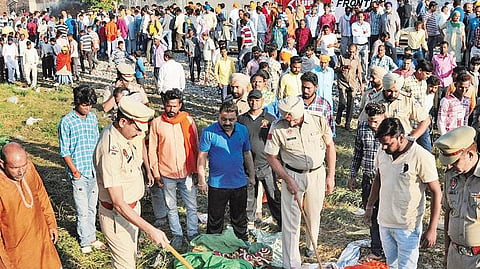
- Home
- Live Blog
- Breaking News
- Top Headlines
- Cities
- NE News
- Sentinel Media
- Sports
- Education
- Jobs

As on April this year, Indian Railways still had 3,479 unmanned crossings in its broad gauge network (out of total 5,792 in all rail gauges), a majority of these in the northern and north-eastern parts of the country. After setting a target in September 2017 to eliminate all unmanned crossings within a year, Railway Minister Piyush Goyal had to review the progress after a train rammed a school van at an unmanned crossing in Kushinagar in Uttar Pradesh on April 25 last, leaving 13 children dead. It was reported that the Railways will eliminate all unmanned crossings by 31st March, 2020; this will be done by manning such crossings, building over-bridges and under-bridges, or creating diversions. Till then, large display hoardings would be put up near such crossings to warn people, and media campaigns will be carried out about the need for caution near rail tracks. But whether unmanned or manned, people take no care at all near railway crossings and corridors. And this utterly feckless and irresponsible attitude extends to those at higher levels who should be knowing better. The Amritsar rail tragedy is a case in point. A municipality ward councillor organised a Dussehra jamboree barely 50 metres away from a busy rail line. Who gave permission for this gathering is being probed, among other things, as part of the magisterial enquiry announced by the Punjab chief minister. The Amritsar municipal authority is claiming it received no application for the gathering, so there was no question of giving permission. Did the police give the go-ahead then? As it usually is with such gatherings and melas, there was no crowd control security arrangement worth the name. A part of the crowd at the back spilled onto the tracks for a better view, even though the manned gate had been closed for trains to pass. Only seconds before the fast train from Jalandhar mowed down 61 persons, a slower train had crossed that very spot heading in the opposite direction from Amritsar. Yet the people refused to take heed — there was much jostling to get a perch at the higher track level and take videos of the burning Dussehra effigies. In the melee and amidst deafening fireworks, they failed to hear the siren or see the train hurtling down on them. The driver has said he had been given the green signal to go at normal speed, that he could not see the crowd on the tracks as they were around a curve and there was thick smoke all around. The Railway authority has stuck to its stand that the site was in the mid-section between two stations where trains run at assigned speed, and there had been no prior intimation of the Dussehra gathering (though it is said to have been held at that site for two decades now). Chief Minister Amarinder Singh has asked officials concerned to frame guidelines, but this disaster is symptomatic of a greater ill afflicting this country. Rules and regulations are framed, then promptly forgotten if not wilfully flouted, often by the very class of people who frame them. As in other fields, this lawlessness has consequences. Unless people at all levels take responsibility for the consequences, what is left in the aftermath is fruitless hand wringing and finger pointing. Human settlements are rapidly spreading beyond rail tracks that were once isolated; there has been a chronic encroachment on railway land along the tracks; all too frequently, irregular markets have sprung up beside rail tracks. People are coming and going across rail tracks at all hours, unmindful of taking the slightest care. When bullet trains are being planned to criss-cross the country, it is sobering to think how we will fare without the Japanese regard for rules. Things can go badly wrong at any time, it is only by following the rules that damage can be mostly forestalled, or at the very least, a better response is mounted in the aftermath.